| « Get To Know Local Artist Clip Art | More Benefits for Madina Lake's Matthew Leone » |
Feature Thu Jul 22 2010
Beyond Vibrations: The Deaf Experience In Music

What is music like when you can't hear it? It's a question that sounds like a philosophical debate on par with trees falling in the woods and single hands clapping, but this is not a question for rhetorical amusement, it's something that audiophiles as well as hearing people in love with signed languages and Deaf culture have thought about in depth. What is the deaf person's experience with an art form that is seemingly only valued by those with fully functioning cochleas?
There is a notion that music is only heard and thus, can only appreciated by the hearing. However, deaf people have a unique and challenging perspective to music that has seldom been explored outside of deaf communities. With in the deaf and hard of hearing world, there are people not only creating music, but people who love and make music a part of their lives. In this world, the various shades of gray are celebrated as the spectrum of deafness, from slightly hard of hearing to "stone deaf" are all part of this community. The experience of sound can be different for many people who's abilities with hearing are not clearly identified in terms that hearing people are used to. it is never an either/or experience, and definitely not something that the hearing world can understand completely. Most assume deaf people enjoy music solely by tactile sensations, but going beyond feeling vibrations, what is the experience of music like for someone who doesn't hear or least least like we do?
Music is felt on a physical level by everyone. Getting a buzzing in our core when the bass is plucked or feeling the power of a drum that mimics our life force is universal. A hearing person can only try to imagine the sensations that are much more developed in a deaf person. One can try touching the ground and placing a back against walls at shows trying to see if they can tell the difference in rhythm and the type of instrument being played by the feelings that hum along the body when the music infiltrates the molecules in in the walls and in ourselves as well. Earplugs are commonly used to protect hearing, but also can be used to try to get as close to heard of hearing as possible for anyone curious to what it might be like to only be able to feel music. Someone who is hearing can switch back and forth from listening and feeling, yet somehow can not have one with out the other and will almost always wind up frustrating as they will hear the music much easier than they can feel it. As someone with no problem responding to sound I often wonder what happens when music meets deaf ears attached to a hearing body?
Jason Johnson is a Co-Chairperson with the Chicago Deaf and Hard of Hearing Cultural Center. 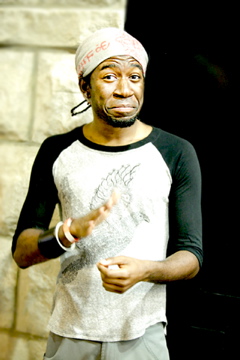
Jason, born deaf and a music fan was excited to experience one of the most interactive and visual bands of recent times, local marching band Mucca Pazza. 
With more members than a ska band, tons of horns and the loudest attitude this side of a Sousa convention, they could be the unofficial hearing band for the deaf community. When I met Jason outside of Lincoln Hall there were odd stares from smokers and staff as we started signing. People have always had a knack for staring at signers, looking on in amazement at hands that make words, a dance of silent conversations. My awareness was not because of the language we were communicating in, I assumed it was the location. What is a deaf dude doing at a music show? The stares were shy and filled with smiles. Was it fascinating or confusing? The idea of deafness and music together still makes little connection to those outside of the culture and those who only hear with their ears.
At this show there was more of a visual aspect to experiencing music than at something like seeing a shoegaze band. As soon as the show beginning Jason starting feeling the speakers to feel sound. We realized the band has no use for them as the band came out through the side, going through the audience to get to the stage playing as they made their way through The feeling of the sound waves leaving the tuba hitting your body firsthand. 
With the band playing good portions of the show in the audience, the
feeling was close to sinful as all senses were being hit with full blown force. Plume hats, dancing, cheerleaders and world class commotion all went along with the music.
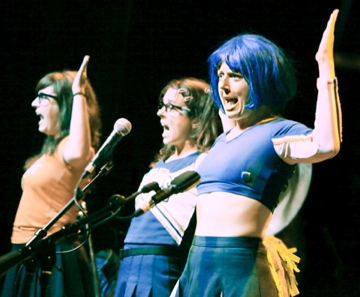
Jason was dancing front row to the music knowing which feeling was made from the brass instruments and which was made from the drums based on a superior ability to feel sound. There has been research that supports that deaf people are able to feel music within the vibrations in the same part of the brain that hearing people use when the melodies we love get caught in our head. I was very curious to how Jason liked the Mucca Pazza show. "I loved them" he told me afterward. "At first I didn't know who they were, but then I felt the vibrations and saw everyone going crazy and loved it! The sound was really fierce and there were different feelings between the trombones and drums!" We forget how multi-sensory music can be, what a physical act it is for our bodies to absorb sound. When I asked Jason to describe Mucca Pazza's music he simply flexed and unflexed his and fingers pushed his palms forward in a silent 4/4 time signature. The translation? "BOOM BOOM BOOM BOOM! All signed with a huge smile.
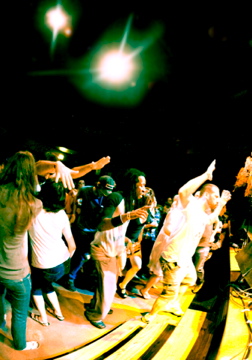
Jason hopes moments like these where deaf people go to non-deaf specific events would be more common. One of the goals of the Chicago Deaf and Hard Of Hearing Cultural Center is to help the cultures combine, network and build a bridge between the hearing, hard of hearing and deaf communities and also according to Jason " have a place of public access for business, media, social networking with the deaf and hard of hearing community. The achievement in this organization is to represent a value of deaf and hard of hearing world that can be share, seen and be able to social in one place where everyone can make anything possible and build networking from business, media, social event with easy place of access". If this were to happen there would be more events that supported Deaf culture from other communities. According to their mission The CDHHCC wants to encourage the general public to recognize, respect and celebrate Deaf culture. This could mean events with more deaf musicians.
Sean Forbes might be one of the first on board in contributing this brave new multi-cultural world. A deaf musician and co-founder of D-PAN, The Deaf Performing Arts Network, a non-profit that helps bring music videos to deaf people, Sean is skimming the lines between two worlds, paving his own road as a leader in the deaf musical community. "I am like a freak at a freak show." Sean says about being a deaf musician. "Some people don't get me, or what I am trying to do." Established in 2007, D-PAN has the goal of creating top-quality ASL-centric music videos. The organization hopes to make music and music culture more accessible to people who have been excluded from participation, mainly the deaf and hard of hearing community .
The ongoing and sometimes unanswerable question to many is why and how do deaf people experience a form of art that to a hearing world assumes they don't have proper tools to enjoy and how are music videos going to help if you can't hear in the first place? The idea of a deaf person getting down to a song, singing along can seem odd or even impossible to so many people. "How does a deaf person know what a song sounds like?" is a question I have been asked when exploring this topic. "Hearing people, don't get it a lot." Sean says For me it is about feeling it." And Sean doesn't just mean just with our bodies. "Hearing people take it for granted that they are hearing it [music]. "Everyone experiences music differently. Some might feel it and some might not." A hearing person tends to process music differently than someone who is deaf. We can rely only on our sense of sound to give us a large part of what a particular song has to offer, but the one aspect of music that doesn't need to be heard is the part that can trigger emotions and feelings.
Sean told me why he started D-PAN. "I think there was a void, so many [deaf] people enjoying music without lyrics. I wanted to make videos inspirational. Music is an escape for many people, I feel like [as] people watching videos, we try to forget about reality."
Even without a complete understanding of the song when you watch one of Sean's videos you are tuned in to a world where music becomes visual and you get excited just watching. Sean's energy and signing is a huge part of what makes his music. As he states in his video "I'm Deaf" he is "giving beats to the hard of hearing" and using signing along with his music is how he makes that happen.
You can get a musical sense of what sound he is creating as he signs his song at warp speed (at the same rate of his rapping) If you are deaf, you get it and if you happen to hear it, you can also see it. He is bringing music to those who can't hear. Deaf since the age of one, he wants to show that you don't have to hear a be a musician. In his videos Sean raps on beat and sings on key about being deaf. Vibrant 1980's inspired closed captioning accompanies the video and becomes Sean's sidekick in the fight against misconceptions about deaf music. Yes, he is rapping and has the beat down, but Sean wants to be clear that he is not a rapper. While his background as a musician is in percussion, Sean is also a lyricist. While some rappers and other hip hop artists use hand gestures as visual communication, when Sean preforms he is in fact "actually saying something" to his audience in American Sign Language. There are a lot of similarities to Sean's style and hip hop, both Deaf culture and hip hop have elements of defending idenity, showing pride and giving information. Sean has been working for years to make his music and is now working with Mark and Jeff Bass, the producers who helped launch Eminem's career.
So could deaf music be the next big genre? Sean said "A lot of deaf people say they don't need music but then when I expose them to it it becomes visual. I want to explain that to other deaf people. I see myself a the deaf music historian. I have been reading and have been exposed to music ever since I was a kid."
Modern music loves to places genre to each descriptive note to help separate and categorize based on who is making the music, what is sounds like and where it comes from. Every culture has a genre and Deaf culture is no exception. Part of deaf music history is Beethoven's Nightmare the first deaf rock band that formed over 30 years ago by three students who met at Gallaudet University, the historic liberal arts university for the deaf. 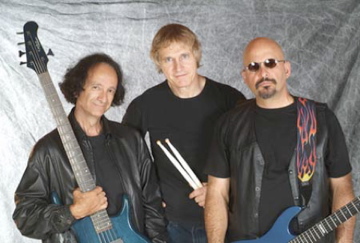 Composed of percussionist Bob Hiltermann, Bassist Ed Chevy and rhythm guitarist Steve Longo, they play a spirited blend of rock music that has elements of surf and metal, but is all deaf rock. The band also takes an educational approach in their songs to help support the deaf identity. It is crucial, just as it is in Sean Forbes's music to identify as deaf. It is a theme that is explored again and again to drill it in to people's heads that deaf people are making music and it isn't a joke. Why is the concept of a deaf musician so odd for hearing people to get? Steve Longo said " [It is] because of the old myth thinking that deaf can't do much without hearing". I think deaf music has a place in deaf and hearing communities because the songs itself describing our language and culture."
Composed of percussionist Bob Hiltermann, Bassist Ed Chevy and rhythm guitarist Steve Longo, they play a spirited blend of rock music that has elements of surf and metal, but is all deaf rock. The band also takes an educational approach in their songs to help support the deaf identity. It is crucial, just as it is in Sean Forbes's music to identify as deaf. It is a theme that is explored again and again to drill it in to people's heads that deaf people are making music and it isn't a joke. Why is the concept of a deaf musician so odd for hearing people to get? Steve Longo said " [It is] because of the old myth thinking that deaf can't do much without hearing". I think deaf music has a place in deaf and hearing communities because the songs itself describing our language and culture."
At the next show you go to, think about how your body responds along with your ears as you take in a favorite song or what power it is to see a facial expression of a musician making it all happen. Hearing is such a small part of music, the rest makes us realize that we are temporary vessels that the music just lives in...until it all fades back to silence.
This feature is supported in part by a Community News Matters grant from The Chicago Community Trust and the John S. and James L. Knight Foundation. More information.









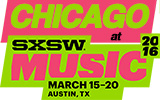






eee / July 22, 2010 11:55 AM
Very interesting read. I married into a family where hearing loss is a genetic condition which increases with age. It's been an eye-opener for me in regards to how those with hearing loss adapt daily. I'm glad there are artists like Sean out there, paving new ground and proving you don't need perfect hearing to appreciate and enjoy music.